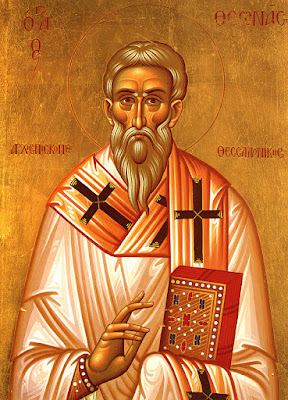 |
| St. Theonas of Thessaloniki (Feast Day - April 4) |
Verses
You are absent Theonas from your presidency below,
Standing before the President of all.
Saint Theonas I, later Archbishop of Thessaloniki, was a disciple of the Holy New Martyr James of Kastoria (Nov. 1). Saint Nikodemos the Hagiorite informs us that we don't know where he was born, who his parents were, or how he came to be chosen as the Archbishop of Thessaloniki. One tradition says he was born in Mytilene, which is why recent scholars say he was from Lesvos, either because he came from there or because he was a spiritual father there in Plomari.
Saint Theonas was probably born in the second half of the 15th century. We know nothing about his life before he went to Mount Athos. At first he lived as an ascetic in the Pantokratoros Monastery, where he was ordained a Priest. Then he joined the brotherhood of Saint Iakovos the Neomartyr, who lived as a monk above Iveron Monastery, in the Skete of the Honorable Forerunner. In around 1518 Saint Iakovos and his brotherhood of six monks, among whom was Theonas, fled to the interior of Mount Athos, and after a vision to the Elder they departed Mount Athos. Thus on Bright Friday in the year 1518 Saint Iakovos and his brotherhood left Mount Athos. After having passed through the region of Thessaloniki and followed the road to Thessaly, and passed through Platamon Castle and Meteora, they settled in the Monastery of the Honorable Forerunner in Analipsis (Dervekista) of Aitolia, where they stayed for one year.
Saint Theonas was the most faithful and best disciple of Saint Iakovos. For this reason he was sent to Bishop Akakios of Arta, in order to receive a letter of permission to ensure their uninterrupted spiritual work among the Christians of the region. But because Saint Iakovos soon became popular with the people, Bishop Akakios came to hate him. So he accepted the slander of certain pseudo-monks and handed Saint Iakovos over to the Turks as a revolutionary. The Turkish Bey of Trikala sent soldiers to arrest Saint Iakovos and two of his disciples, Deacon Iakovos and Monk Dionysios, and they were taken to Trikala, where they were imprisoned for forty days. They were visited in prison by two other disciples of Saint Iakovos, Theonas and Markianos, and asked about the fate of the monastery and brotherhood after his death. Iakovos prophecied that they would abandon the monastery and would gather in a monastery near Thessaloniki. He also sent a letter to his disciples, in which he ordered for Theonas to be his successor and the abbot of the Monastery of the Forerunner.
On November 1st in the year 1519 Saint Iakovos and his two disciples, Iakovos and Dionysios, after being horribly tortured in Didymoteicho and Adrianople (Edirne), were hanged. The sacred relics of these three New Martyrs were purchased by Christians and buried in the village of Arvanitochori, five kilometers from Adrianople.
According to the prophecy of Saint Iakovos, after his death Theonas and the brotherhood in Dervekista left the monastery the following year and went to Mount Athos, to Simonopetra Monastery. From a certain priest in Arta they were informed about the graves of the New Martyrs, so they took care towards the translation of their sacred relics to Mount Athos. In 1522 the brotherhood left Simonopetra with the relics of the New Martyrs and came to the outskirts of Thessaloniki. They settled in the Monastery of Saint Anastasia the Pharmakolytria, which was then a very old and small monastery, they thoroughly reconstructed it with competent cells for the monks, and by the grace of God one hundred and fifty monks came there and lived the cenobitic life.
Saint Theonas was abbot of the Monastery of Saint Anastasia, according to various sources, until 1535. His ascent to the hierarchical throne of Thessaloniki must have taken place around 1535, because the Metropolitan of Thessaloniki was Joasaph until 1535, and in a document from 1538 Saint Theonas is referred to as the Metropolitan of Thessaloniki.
He was not the Metropolitan of Thessaloniki for many years, because in May of 1541 he is referred to as the Metropolitan of Thessaloniki, while in April of 1542 he is referred to as dead. Therefore he probably reposed in 1541.
The sacred relic of Saint Theonas, immediately after his repose, was translated in a miraculous way to the Monastery of Saint Anastasia. In 1821 it was brought to Skopelos, and from there to Esphigmenou Monastery at Mount Athos, and then was again brought to the Monastery of Saint Anastasia, where it is reverently kept today and has been preserved incorrupt. His feast day is celebrated on April 4th, but is kept in the Monastery of Saint Anastasia on the Fourth Sunday of Great Lent.
Apolytikion in Plagal of the Fourth Tone
Guide of Orthodoxy, teacher of piety and modesty, the beauty of monastics, and the inspired ornament of hierarchs, Theonas our Venerable Father, the boast of Thessaloniki, the lyre of the Spirit, entreat that all of our souls may be saved.
Kontakion in the Second Tone
Divinely inspired shepherd of Thessaloniki, and our mighty intercessor to God, ever intercede wise Theonas, that from all our needs and troubles will be redeemed, we who with longing honor you Holy One.
Megalynarion
In asceticism you shined brightly, and you were made worthy of theoria beyond words; whence you are a divine gem, the shepherd of Thessaloniki, and showed yourself to be a God-bearer, Holy Theonas.
The Hut of St. Theonas, where he lived in asceticism at the Monastery of Saint Anastasia.
